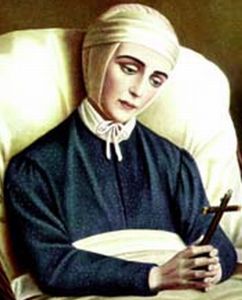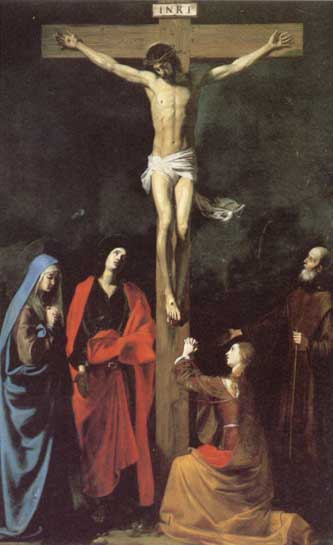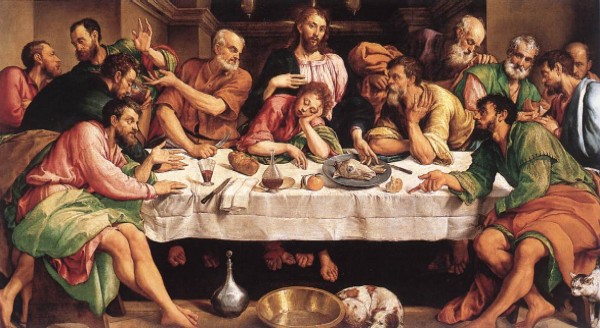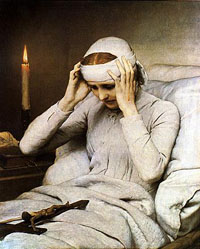|
Anne Catherine Emmerich When Anne Catherine Emmerich was born in rural Germany in 1774, her parents could scarcely have imagined their beautiful little baby would be stirring up trouble for the next 230-plus years.
When Anne Catherine Emmerich was born in rural Germany in 1774, her parents could scarcely have imagined their beautiful little baby would be stirring up trouble for the next 230-plus years. Emmerich was born poor, lived poor and eventually died poor. She worked in various lower-class jobs for the first 28 years of her life, then entered a convent to devote her life to God. The nuns were not amused by young Anne, who gave them headaches with her extreme devotion, poor health and supernatural phenomena. The first two could probably have been overlooked, but the third was problematic. Since childhood, Emmerich was said to have mysterious powers, including clairvoyance, the ability to heal others and frequent visions of divine luminaries, including the Virgin Mary and Jesus, to whom she referred (somewhat creepily) as "my Divine Spouse." Her Divine Spouse had an abusive streak. Emmerich was haunted by visions of sinners being punished in the afterlife and was often afflicted with stigmata (spontaneously occurring wounds corresponding to the wounds of Christ on the cross). Her stigmata included the unauthorized addition of a bleeding wound on her breasts in the shape of the cross. Emmerich also reportedly had an unerring ability to sense the presence of the Holy Eucharist and saintly relics, a skill of arguably limited utility.
Some of the visions remain mysterious in content, including messages reportedly sent to Pope Pius VII, which may have contained some of her prophecies for the future decline of the papacy, the war of Armageddon and the Apocalypse. All these visions have a certain theatrical flair, but Emmerich is best remembered for one specific series of revelations -- The Dolorous Passion of Our Lord Jesus Christ. Emmerich dictated her lengthy narrative of the last days of Jesus to Klemens Brentano, a prominent German poet starting in 1818. The Dolorous Passion was published fifteen years later, but Emmerich didn't live to see it. She died in 1824, succumbing to her longtime frailty and sadistic abuse at the hands of God (who continued to afflict her with stigmata despite her prayers to be relieved). The Dolorous Passion was a lengthy series of visions, sometimes contradicting the New Testament and even contradicting itself in various places. The text reads like the director's special extended version of the Passion story presented in the biblical Gospels, folding a host of additional details and local color into the original tale. Some of these changes were incidental to the content of the Gospel stories, but some were not. Much of Emmerich's Passion was loosely grounded in historical fact and the geography of Palestine, which was at first seen as evidence of their authenticity given Emmerich's simple upbringing and lack of advanced education. On the other hand, it's quite possible that the extremely well-educated Brentano may have been unable to contain his urge toward poetic license as he dutifully "transcribed" Emmerich's words. (At least one author, working with original German source material, has advanced a compelling argument that Brentano and Emmerich were entangled in a weird and unseemly love affair in which repressed sexual scenes played out at the same time that her divine visions were being received.) Regardless of exactly how the elements came together, The Dolorous Passion is quite memorable in its literary take on the events of Christ's arrest, trial, execution and presumed resurrection. However, it's the unauthorized additions which are really interesting.
Fortunately for the orthodox view, Emmerich's secret revelations served to reinforce Catholic doctrines, including a long sequence in which Jesus expressly authorizes many practices that the Church somehow neglected to implement until centuries later. The Dolorous Passion also depicts Jesus spelling out later Catholic doctrines such as the apostolic succession from Peter and the exclusion of women from the priesthood.
Emmerich's accounts were rife with superstition and anti-Semitism, the former evidenced in a mild obsession with relics, such as Veronica's veil, the wood of the cross and the Holy Grail, which she said had been handed down from Abraham. The anti-Semitic content constituted a major obsession. Although the essential context for Emmerich's viewpoint on the Jews was derived from the Gospels and colored by the contemporary social views of her day, the fact is that The Dolorous Passion has a whole lot to say about Jews, most of it bad. For instance:
The appearance of Jesus, when he passed through the midst of the crowd who were already assembled in the front of the house, was that of a victim led to be sacrificed; his countenance was totally changed and disfigured from ill-usage, and his garments stained and torn; but the sight of his sufferings, far from exciting a feeling of compassion in the hard hearted Jews, simply filled them with disgust, and increased their rage. Pity was, indeed, a feeling unknown in their cruel breasts. The visions dwell on the depredation and cruelty of the Jews against Jesus in some detail. While Emmerich's telling is more lurid than the biblical version, The Dolorous Passion's reputation for being anti-Semitic is somewhat overblown. Or rather, it would be overblown if not for this particular passage: Whenever, during my meditations on the Passion of our Lord, I imagine I hear that frightful cry of the Jews, 'His blood be upon us, and upon our children,' visions of a wonderful and terrible description display before my eyes at the same moment the effect of that solemn curse. I fancy I see a gloomy sky covered with clouds, of the colour of blood, from which issue fiery swords and darts, lowering over the vociferating multitude; and this curse, which they have entailed upon themselves, appears to me to penetrate even to the very marrow of their bones, even to the unborn infants. It's hard to see how this can be read as anything but a broad condemnation of Jews of every generation, through the present day and beyond. Although this is the most explicit expression of full-blown anti-Semitism in The Dolorous Passion, Emmerich's other visions were even more parochial and racist. One of her biographers recorded the following: The soul of the old Jewess Meyr told me on the way that it was true that in former times the Jews, both in our country and elsewhere, had strangled many Christians, principally children, and used their blood for all sort of superstitious and diabolical practices. She had once believed it lawful; but she now knew that it was abominable murder. They still follow such practices in this country and in others more distant; but very secretly, because they are obliged to have commercial intercourse with Christians.
The cause of sainthood took a big step forward in 1891, when researchers used Emmerich and Brentano's Life of the Virgin Mary to find a house where the Virgin had supposedly lived in Ephesus. The house was reasonably close to the description in the visions, and one year later, Emmerich was named "venerable," the first of three ranks culminating in Catholic sainthood. Unfortunately for the cause, someone must have gone back and re-read that chapter on the Jews. The canonization process was halted in 1928, purportedly because the Church had begun to suspect that Brentano was the primary author of The Dolorous Passion and Emmerich's other works. (The church agreed to reexamine the case in 1979, with the stipulation that any further move toward canonization would be based only on Emmerich's life and not her alleged writings.) Interestingly, the canonization process was halted by the Sacred Congregation of the Holy Office -- aka the Inquisition. Perhaps those secret teachings weren't so orthodox after all. Or maybe the sudden reversal had something to do Emmerich's prophecies that the Church would soon become hopelessly corrupt.
Perhaps not coincidentally, Gibson belongs to a fringe Catholic sect that rejected the reforms instituted during the Vatican II council, which perhaps not coincidentally included an official statement absolving the Jews from any and all collective racial responsibility for killing God. The Passion depicted every gore-soaked detail from The Dolorous Passion in Technicolor splendor to a slavering audience of extremely earnest Christians. Many of these Christians ignorantly praised the movie's exact recreation of the Gospels, despite the numerous and significant variations (nearly all of which were derived from The Dolorous Passion). The movie was released in 2004 amid a firestorm of controversy. Many viewers were reduced to devout tears -- or screeching nervous breakdowns -- by the film's relatively extreme violence. "Relatively" because although it managed an R rating, many Passion viewers were conservative Christians who had not been appropriately desensitized to violence by such cinematic classics as Hollywood Chainsaw Hookers and Suspira. The Passion produced many entertaining anecdotes, such as several stories of dramatic conversions by viewers, including a murderer who turned himself in after seeing the movie (then reneged and pleaded "not guilty" when his hearing came around). The movie also provided a rare bright spot in U.S.-Arab relations. The Passion was a big hit in Muslim countries (where Jesus is revered as a prophet), again prompting audience members to tears, such as the young woman in Jordan who proclaimed on exiting the theater, "(It) unmasked the Jews' lies and I hope that everybody, everywhere, turns against the Jews." Charming. Gibson and Emmerich (and maybe Brentano) must be very proud. Full text: The Dolorous Passion of Our Lord Jesus Christ |
 In short, Emmerich was your run-of-the-mill obscurantist would-be saint, holy in her obscurity and mystical in bent. That began to change in 1813, when she became bedridden and began a more aggressive series of visions.
In short, Emmerich was your run-of-the-mill obscurantist would-be saint, holy in her obscurity and mystical in bent. That began to change in 1813, when she became bedridden and began a more aggressive series of visions. 
 In a striking addition to the Gospel narratives, Jesus and his apostles are continually hounded by devils and demons of various stripes, who lurk and skulk and generally stink up the place, paying particular attention to
In a striking addition to the Gospel narratives, Jesus and his apostles are continually hounded by devils and demons of various stripes, who lurk and skulk and generally stink up the place, paying particular attention to  To 19th century Catholics the positives seemed to outweigh the negatives, even among those few 19th century Catholics who would have objected to the anti-Semitic content in the first place. Emmerich's body was exhumed a few years after her death, when rumors began to fly that her body had been stolen. The corpse was in good repair and had entirely escaped the worms, which the church considers to be a miracle called "incorruptibility" (except when it happens to
To 19th century Catholics the positives seemed to outweigh the negatives, even among those few 19th century Catholics who would have objected to the anti-Semitic content in the first place. Emmerich's body was exhumed a few years after her death, when rumors began to fly that her body had been stolen. The corpse was in good repair and had entirely escaped the worms, which the church considers to be a miracle called "incorruptibility" (except when it happens to  All this controversy may have bothered the mainstream church, but it didn't trouble Hollywood star Mel Gibson. Previously best known for portraying such upstanding moral icons as post-Apocalyptic gunslinger "Mad Max," Gibson funded and directed a $50 million vanity project based on Emmerich's alleged writings, the now-infamous splatter spectacular, The Passion of the Christ.
All this controversy may have bothered the mainstream church, but it didn't trouble Hollywood star Mel Gibson. Previously best known for portraying such upstanding moral icons as post-Apocalyptic gunslinger "Mad Max," Gibson funded and directed a $50 million vanity project based on Emmerich's alleged writings, the now-infamous splatter spectacular, The Passion of the Christ.